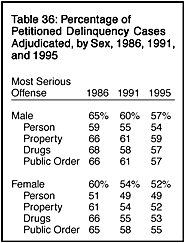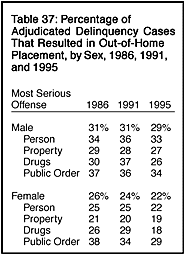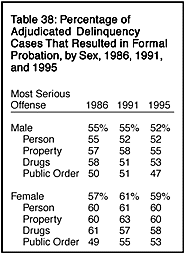|
Sex Judicial Decision and Disposition
Cases involving male juveniles were more likely than cases involving females to be adjudicated once petitioned (57% compared with 52%) (table 36). This pattern was found in all four offense categories. For males, the probability of adjudication was greatest in cases involving property offenses (59%). For females, the probability of adjudication was greatest in cases involving public order offenses (55%). The probability of adjudication decreased between 1986 and 1995 for formally handled cases involving males (from 65% to 57%) and females (from 60% to 52%). The proportion of formally processed cases resulting in adjudication decreased among all offense categories for both sexes. Once adjudication occurred, cases involving male delinquents were more likely than those involving females to result in out-of-home placement in 1995 (table 37). Placement was the most restrictive disposition in 29% of adjudicated cases involving males and 22% of those involving females. For both males and females, higher proportions of person and public order cases resulted in residential placement than did property or drug cases. Between 1986 and 1995, the use of placement declined slightly for both males and females.
Formal probation was ordered in 52% of adjudicated delinquency cases involving males and 59% of those involving females in 1995 (table 38). The use of formal probation for adjudicated males and females changed somewhat between 1986 and 1995. The likelihood of probation decreased slightly for cases involving males (from 55% to 52%) and increased slightly for females (from 57% to 59%).
|



